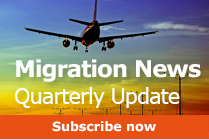This study focuses on the incentives and disincentives for migrants to return [1] to the sending country. It is important to understand why people move away from their country and what will stimulate them to return temporary or permanently. The success of policies to stimulate circular- and return migration is conditional on the impact of the policy instrument on the behaviour of migrants (and potentially their employers).
Circular migration is high on the international agenda of migration and development [2]. This form of legal migration is often presented as an answer to the challenge to create a situation in which migration could yield a triple-win for migrants and sending and receiving countries. At the same time, circular migration seems to address two different policy concerns. On the one hand, developed economies seem to prefer to host foreign workers as long as the economy needs them, but would like to avoid permanent settling of the migrant workers in order to guarantee that in economic downturns labour supply is not further increased when the demand for labour is declining to avoid repetition of failures of past temporary migration programs. On the other hand, developing countries ask for more possibilities for legal labour migration. Developed economies also want to stimulate circular migration because it is believed that return migration may counteract the negative effects of brain drain for the sending country.
Circular migration is not new. For a very long period (between the late 1950s and the early 1980s) the Netherlands assumed that the “guest workers” would only be temporary guests in the economy and the society implying a concept of circular migration “avant la lettre”. Overall, only a limited number of migrant workers returned: the majority stayed despite severe economic crises and a host country that was not really welcoming them.
When designing a new scheme for circular migration it is important to understand why people move away from their country and what will stimulate them to return temporary or permanently. The success of policies to stimulate circular- and return migration is conditional on the impact of these policies have on the behaviour of migrants (and potentially their employers). This project will look at the role of return migration in the life cycle of migrants and their families. This will form the basis for a policy study that focuses on the incentives and disincentives for migrants to return to the country of origin.
This inspires research to investigate under what conditions return works. Three issues seem to be pivotal in this respect:
Do the relations and the endowments of the migrants within the welfare pentagons [3] of the sending and the receiving country stimulate or refrain migrants to return at a certain point in time; it might be that modern communication- and travel technology allows them to keep in closer contact with the sending country institutions compared to the situation in the previous century; on the other hand, it may be that the investments of migrants in financial, human and social capital in the receiving countries are now becoming more important due to the incentives provided by the hosting country to assimilate and integrate more fully; if that is the case, these investments would tie them to the receiving country;
- How does return migration fit within the life cycle of migrants workers and migrants coming to developed countries for other reasons (family reunification, asylum)?
- Under what circumstances do returnees have a positive/negative impact on development? Can reintegration schemes make a positive contribution? Factors like permanent or temporary work/residence permits and voluntary or forced return will be taken into account.
Given the answers to these questions, the policy options at national and European level for stimulating circular and return migration will be explored, discussed and compared with (best) practices in other countries.
The data collected in the data base are organized to answer the empirical questions formulated above. Policy analytical research will complement the study on the micro level.
[1]
All forms of return migration are studied: these include temporary movements and permanent movements of people between countries of origin and countries of destination.
[2]
Circular migration in a global context is used as a triple win discourse promising gains for host countries, home countries and migrants themselves, promising accelerated economic growth, remittances, relative high wages and brain gain, by means of full circles of migration: immigrants should be able to come, go and come back again, without many restrictions and making use of contemporary transnational networks. (Bieckmann and Muskens, 2007). Return migration is the process by which a migrant returns to their country of origin (usually to stay) after being away for a particular period of time.
[3]
The Welfare Pentagon represents the five core institutions that households may use to satisfy current and future needs in a given society: family, markets, social networks, membership institutions and public authorities (see Figure 1). Even though historical and geographical appearances differ, these institutions are found in all societies across time and locations. The relevance of each institution and the exchanges between households and these institutions may differ by society and over time. Households use the institutions of the Welfare Pentagon in their livelihood strategy in order to generate income but also to smooth consumption.




